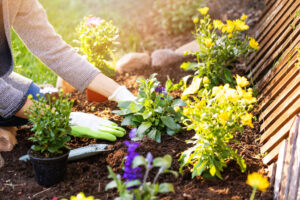
In recent years, the importance of eco-friendly gardening has gained significant momentum. As climate change and environmental degradation become more pressing concerns, adopting sustainable gardening practices can play a crucial role in preserving our planet. This guide will provide you with comprehensive tips on implementing eco-friendly gardening techniques to contribute to a greener future.
Understanding Eco-Friendly Gardening
Eco-friendly gardening, also known as sustainable or green gardening, focuses on minimizing environmental impact while maintaining a healthy and productive garden. It involves using techniques and practices that promote ecological balance, conserve resources, and reduce waste. By integrating these methods into your gardening routine, you can help protect natural ecosystems, conserve energy, and support biodiversity.
1. Choosing Native Plants
One of the fundamental principles of eco-friendly gardening is selecting native plants for your garden. Native plants are adapted to the local climate and soil conditions, making them more resilient and requiring less water and fertilizer. They also provide essential habitat and food for local wildlife, including pollinators like bees and butterflies.
Benefits of Native Plants:
- Water Efficiency: Native plants have evolved to thrive with local rainfall, reducing the need for supplemental watering.
- Reduced Pesticide Use: They are less susceptible to pests and diseases, minimizing the need for chemical interventions.
- Biodiversity Support: Native plants contribute to a balanced ecosystem by providing resources for native wildlife.
Tips for Choosing Native Plants:
- Research Local Species: Consult local horticultural experts or online resources to identify native plants suited to your region.
- Consider Seasonal Blooms: Select a variety of plants that bloom at different times to provide continuous food sources for pollinators.
- Incorporate Ground Covers: Use native ground covers to reduce soil erosion and competition from weeds.
2. Implementing Water Conservation Techniques
Water conservation is a critical aspect of eco-friendly gardening. Implementing efficient watering techniques can help reduce water usage and minimize the impact on local water resources.
Effective Water Conservation Methods:
- Drip Irrigation: Install a drip irrigation system to deliver water directly to plant roots, reducing evaporation and runoff.
- Rain Barrels: Collect and store rainwater in barrels to use for garden irrigation. This method conserves municipal water supplies and provides plants with natural rainwater.
- Mulching: Apply organic mulch around plants to retain soil moisture, suppress weeds, and regulate soil temperature.
Additional Tips:
- Watering Timing: Water your garden early in the morning or late in the evening to minimize evaporation losses.
- Check for Leaks: Regularly inspect irrigation systems and hoses for leaks or malfunctions.
3. Promoting Soil Health
Healthy soil is the foundation of a thriving garden. Implementing practices that enhance soil fertility and structure can lead to better plant growth and reduce the need for synthetic fertilizers.
Soil Health Practices:
- Composting: Create a compost pile or bin to recycle organic waste, such as kitchen scraps and yard trimmings. Compost improves soil structure, provides essential nutrients, and reduces waste sent to landfills.
- Cover Crops: Plant cover crops, such as clover or rye, during the off-season to prevent soil erosion, enhance soil fertility, and suppress weeds.
- No-Till Gardening: Avoid disturbing the soil through excessive tilling. Instead, use no-till or minimal-till methods to preserve soil structure and promote beneficial microorganisms.
Additional Tips:
- Soil Testing: Conduct regular soil tests to monitor nutrient levels and pH, allowing for targeted soil amendments.
- Organic Fertilizers: Use natural or organic fertilizers, such as fish emulsion or bone meal, to provide essential nutrients without the negative environmental impact of synthetic fertilizers.
4. Reducing Chemical Use
Minimizing the use of chemicals, such as pesticides and herbicides, is crucial for an eco-friendly garden. Chemicals can harm beneficial insects, contaminate water sources, and disrupt soil ecosystems.
Alternatives to Chemical Use:
- Integrated Pest Management (IPM): Adopt IPM strategies to manage pests using a combination of biological, cultural, and physical controls. This approach reduces reliance on chemical pesticides and promotes ecological balance.
- Natural Pest Controls: Introduce beneficial insects, such as ladybugs and lacewings, to control pest populations naturally. Use organic pest repellents, such as neem oil or insecticidal soap, when necessary.
- Hand Weeding: Remove weeds manually or use tools like a hoe to control weed growth without resorting to herbicides.
Additional Tips:
- Encourage Beneficial Wildlife: Create habitats for wildlife that can help control pests, such as birdhouses or insect hotels.
5. Energy-Efficient Garden Design
Designing your garden with energy efficiency in mind can help reduce your overall environmental footprint. Implementing energy-efficient practices can lead to lower energy consumption and improved sustainability.
Energy-Efficient Design Tips:
- Shade Trees: Plant trees strategically to provide shade for your home, reducing the need for air conditioning during hot weather.
- Windbreaks: Use hedges or trees to create windbreaks, which can reduce heating costs by protecting your home from cold winds.
- Solar-Powered Garden Lights: Choose solar-powered lighting options for garden illumination, reducing electricity consumption and minimizing environmental impact.
Additional Tips:
- Design for Efficiency: Plan your garden layout to maximize energy efficiency, such as placing herb and vegetable gardens close to the kitchen for easy access.
6. Encouraging Biodiversity
Biodiversity is essential for a healthy garden ecosystem. Encouraging a diverse range of plants, animals, and microorganisms can improve resilience and contribute to ecological balance.
Ways to Promote Biodiversity:
- Plant Diversity: Grow a variety of plants, including flowering plants, shrubs, and trees, to create a diverse habitat for wildlife.
- Wildlife-Friendly Features: Incorporate features such as birdbaths, nesting boxes, and pollinator gardens to attract and support various species.
- Avoid Monocultures: Avoid planting large expanses of a single crop or plant species, as this can lead to pest problems and reduced biodiversity.
Additional Tips:
- Create Wildlife Corridors: Design your garden to include pathways and connections that allow wildlife to move freely between habitats.
Conclusion
Implementing eco-friendly gardening techniques is a powerful way to contribute to a greener future. By choosing native plants, conserving water, promoting soil health, reducing chemical use, designing energy-efficient gardens, and encouraging biodiversity, you can create a sustainable and thriving garden that benefits both the environment and your local ecosystem. Embrace these practices to make a positive impact and enjoy the rewards of a beautiful, eco-friendly garden.

